动词时态学案概要
初中动词的时态 教案
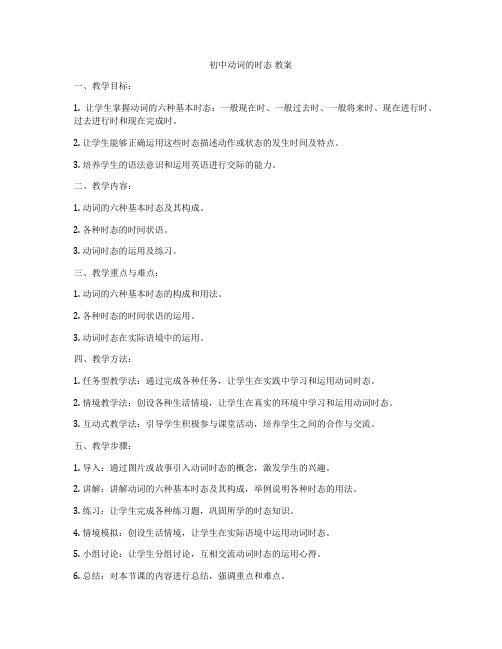
初中动词的时态教案一、教学目标:1. 让学生掌握动词的六种基本时态:一般现在时、一般过去时、一般将来时、现在进行时、过去进行时和现在完成时。
2. 让学生能够正确运用这些时态描述动作或状态的发生时间及特点。
3. 培养学生的语法意识和运用英语进行交际的能力。
二、教学内容:1. 动词的六种基本时态及其构成。
2. 各种时态的时间状语。
3. 动词时态的运用及练习。
三、教学重点与难点:1. 动词的六种基本时态的构成和用法。
2. 各种时态的时间状语的运用。
3. 动词时态在实际语境中的运用。
四、教学方法:1. 任务型教学法:通过完成各种任务,让学生在实践中学习和运用动词时态。
2. 情境教学法:创设各种生活情境,让学生在真实的环境中学习和运用动词时态。
3. 互动式教学法:引导学生积极参与课堂活动,培养学生之间的合作与交流。
五、教学步骤:1. 导入:通过图片或故事引入动词时态的概念,激发学生的兴趣。
2. 讲解:讲解动词的六种基本时态及其构成,举例说明各种时态的用法。
3. 练习:让学生完成各种练习题,巩固所学的时态知识。
4. 情境模拟:创设生活情境,让学生在实际语境中运用动词时态。
5. 小组讨论:让学生分组讨论,互相交流动词时态的运用心得。
6. 总结:对本节课的内容进行总结,强调重点和难点。
7. 作业布置:布置相关的课后练习,让学生巩固所学知识。
六、教学评价:1. 课堂参与度:观察学生在课堂活动中的积极参与程度,以及与合作成员的互动情况。
2. 练习完成情况:检查学生完成练习题的正确率,了解学生对动词时态的掌握程度。
3. 情境模拟:评估学生在实际语境中运用动词时态的准确性和流利度。
4. 课后作业:批改学生的课后作业,了解学生对课堂所学知识的巩固情况。
通过以上教学设计,希望能够帮助学生系统地学习和掌握动词的八种时态,提高他们的英语语法水平和交际能力。
初中英语谓语动词时态教案
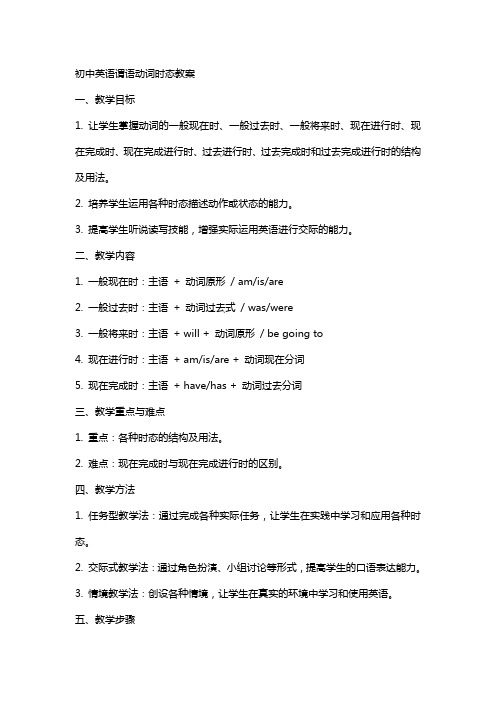
初中英语谓语动词时态教案一、教学目标1. 让学生掌握动词的一般现在时、一般过去时、一般将来时、现在进行时、现在完成时、现在完成进行时、过去进行时、过去完成时和过去完成进行时的结构及用法。
2. 培养学生运用各种时态描述动作或状态的能力。
3. 提高学生听说读写技能,增强实际运用英语进行交际的能力。
二、教学内容1. 一般现在时:主语+ 动词原形/ am/is/are2. 一般过去时:主语+ 动词过去式/ was/were3. 一般将来时:主语+ will + 动词原形/ be going to4. 现在进行时:主语+ am/is/are + 动词现在分词5. 现在完成时:主语+ have/has + 动词过去分词三、教学重点与难点1. 重点:各种时态的结构及用法。
2. 难点:现在完成时与现在完成进行时的区别。
四、教学方法1. 任务型教学法:通过完成各种实际任务,让学生在实践中学习和应用各种时态。
2. 交际式教学法:通过角色扮演、小组讨论等形式,提高学生的口语表达能力。
3. 情境教学法:创设各种情境,让学生在真实的环境中学习和使用英语。
五、教学步骤1. 导入:通过图片或情境引入本课主题,激发学生兴趣。
2. 讲解:讲解各种时态的结构及用法,举例说明。
3. 练习:让学生完成各种练习题,巩固所学知识。
4. 交际:分组进行角色扮演或小组讨论,运用所学时态进行交际。
5. 总结:对本课内容进行总结,强调重点和难点。
6. 作业:布置相关作业,让学生巩固所学知识。
7. 拓展:介绍一些常用的动词短语,扩大学生的词汇量。
六、教学评估1. 课堂观察:观察学生在练习和交际过程中的表现,了解他们的掌握程度。
2. 练习答案:检查学生作业和练习册的完成情况,评估他们的学习效果。
3. 口语测试:组织口语测试,评估学生在实际情境中运用各种时态的能力。
七、教学反馈1. 针对学生的弱点进行有针对性的辅导。
2. 鼓励学生多练习,提高运用英语进行交际的能力。
教育辅导个性化教案动词的时态
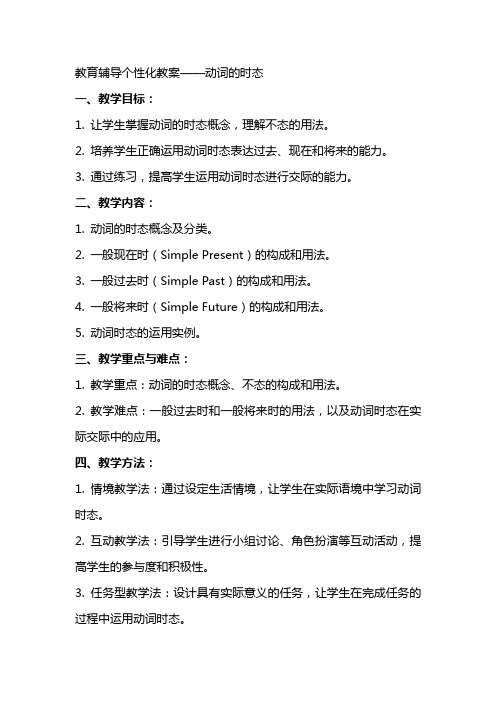
教育辅导个性化教案——动词的时态一、教学目标:1. 让学生掌握动词的时态概念,理解不态的用法。
2. 培养学生正确运用动词时态表达过去、现在和将来的能力。
3. 通过练习,提高学生运用动词时态进行交际的能力。
二、教学内容:1. 动词的时态概念及分类。
2. 一般现在时(Simple Present)的构成和用法。
3. 一般过去时(Simple Past)的构成和用法。
4. 一般将来时(Simple Future)的构成和用法。
5. 动词时态的运用实例。
三、教学重点与难点:1. 教学重点:动词的时态概念、不态的构成和用法。
2. 教学难点:一般过去时和一般将来时的用法,以及动词时态在实际交际中的应用。
四、教学方法:1. 情境教学法:通过设定生活情境,让学生在实际语境中学习动词时态。
2. 互动教学法:引导学生进行小组讨论、角色扮演等互动活动,提高学生的参与度和积极性。
3. 任务型教学法:设计具有实际意义的任务,让学生在完成任务的过程中运用动词时态。
五、教学步骤:1. 引入:通过提问方式引导学生思考动词的不同形式,激发学生的学习兴趣。
2. 讲解:讲解动词的时态概念,介绍一般现在时、一般过去时和一般将来时的构成和用法。
3. 练习:设计相关练习题,让学生巩固所学知识。
4. 互动活动:分组进行角色扮演,让学生在实际语境中运用动词时态。
5. 总结:对本节课所学内容进行总结,强调动词时态的重要性和用法。
6. 作业布置:布置练习题,让学生课后巩固所学知识。
六、教学评估:1. 课堂观察:观察学生在课堂上的参与程度、互动情况和学习效果。
2. 练习题:评估学生在练习题中的答题情况,检验他们对动词时态的掌握程度。
3. 角色扮演:评价学生在互动活动中的表现,观察他们是否能正确运用动词时态。
七、课后作业:1. 完成练习题:要求学生课后完成相关练习题,巩固所学知识。
2. 家庭作业:布置有关动词时态的家庭作业,让学生在实际语境中运用。
八、拓展活动:1. 动词时态手抄报:让学生制作关于动词时态的手抄报,增加学习兴趣。
初中英语动词时态教案
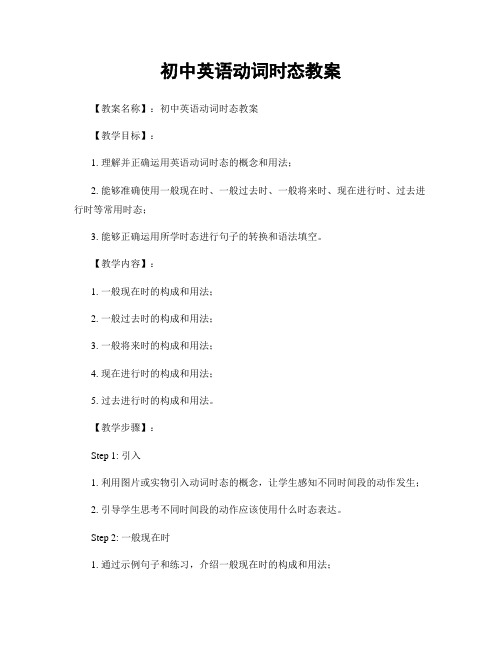
初中英语动词时态教案【教案名称】:初中英语动词时态教案【教学目标】:1. 理解并正确运用英语动词时态的概念和用法;2. 能够准确使用一般现在时、一般过去时、一般将来时、现在进行时、过去进行时等常用时态;3. 能够正确运用所学时态进行句子的转换和语法填空。
【教学内容】:1. 一般现在时的构成和用法;2. 一般过去时的构成和用法;3. 一般将来时的构成和用法;4. 现在进行时的构成和用法;5. 过去进行时的构成和用法。
【教学步骤】:Step 1: 引入1. 利用图片或实物引入动词时态的概念,让学生感知不同时间段的动作发生;2. 引导学生思考不同时间段的动作应该使用什么时态表达。
Step 2: 一般现在时1. 通过示例句子和练习,介绍一般现在时的构成和用法;2. 强调第三人称单数形式的变化规则,进行练习巩固;3. 练习时,可以结合学生生活中的日常活动,如:I eat breakfast every day. He plays soccer on weekends.等。
Step 3: 一般过去时1. 通过示例句子和练习,介绍一般过去时的构成和用法;2. 强调动词过去式的变化规则,进行练习巩固;3. 练习时,可以结合学生过去发生的事情,如:Yesterday, I watched a movie. She visited her grandparents last summer.等。
Step 4: 一般将来时1. 通过示例句子和练习,介绍一般将来时的构成和用法;2. 强调使用助动词will或be going to来表示将来动作的规则,进行练习巩固;3. 练习时,可以结合学生未来的计划或打算,如:I will go shopping tomorrow. They are going to visit the zoo next week.等。
Step 5: 现在进行时1. 通过示例句子和练习,介绍现在进行时的构成和用法;2. 强调动词进行时的变化规则,进行练习巩固;3. 练习时,可以结合学生当前正在进行的动作,如:She is reading a book. They are playing basketball.等。
动词时态教案

动词时态教案一、教学目标1. 熟练掌握英语中常见的动词时态形式和用法。
2. 能够根据语境正确运用不同的动词时态。
3. 培养学生对时态转换的敏感度,提高语言表达的准确性和流利程度。
二、教学重难点1. 动词时态的基本概念和分类。
2. 各时态的构成和用法。
3. 时态转换的要点和技巧。
三、教学准备教材:教科书、练习册教具:投影仪、录音机、黑板、白板、笔四、教学过程Step 1: 引入新知1. 向学生介绍动词时态的概念:动词时态是指动词表示的动作或状态发生的时间。
2. 提问学生:英语中有哪些常见的动词时态?引导学生提到一般现在时、一般过去时、一般将来时等。
写在黑板上。
Step 2: 一般现在时1. 教师板书:主语 + 动词原形 + 其他。
2. 向学生解释一般现在时的构成和用法,例如:表示经常性、习惯性或普遍真理的动作或状态。
3. 给出一些例句并要求学生跟读。
4. 分组活动:学生根据给定的语境,描述人物的日常活动。
例如:My friend often (play) soccer after school.Step 3: 一般过去时1. 教师板书:主语 + 动词过去式 + 其他。
2. 向学生解释一般过去时的构成和用法,例如:表示过去某个时间发生的动作或状态。
3. 给出一些例句并要求学生跟读。
4. 练习:学生根据给定的情境,将动词的时态改为一般过去时。
例如:I (go) to the park yesterday.Step 4: 一般将来时1. 教师板书:主语 + will/shall + 动词原形 + 其他。
2. 向学生解释一般将来时的构成和用法,例如:表示将来某个时间要发生的动作或状态。
3. 给出一些例句并要求学生跟读。
4. 练习:学生根据给定的情境,将动词的时态改为一般将来时。
例如:They (visit) their grandparents next week.Step 5: 混合时态1. 教师板书:主语 + 动词过去式 + 其他;主语 + will/shall + 动词原形 + 其他。
动词的时态讲义及教案

动词的时态最新讲义及教案第一章:引言1.1 教学目标了解动词时态的概念和重要性掌握动词的基本时态及其用法1.2 教学内容动词时态的定义和分类一般现在时、一般过去时、一般将来时的用法1.3 教学方法讲解法:讲解动词时态的概念和用法互动法:引导学生参与课堂活动,巩固所学知识第二章:一般现在时2.1 教学目标掌握一般现在时的构成和用法能够正确运用一般现在时描述习惯、状态和普遍真理2.2 教学内容一般现在时的构成:主语+动词原形一般现在时的用法:描述习惯、状态、普遍真理等2.3 教学方法讲解法:讲解一般现在时的构成和用法练习法:设计相关练习题,巩固一般现在时的运用第三章:一般过去时3.1 教学目标掌握一般过去时的构成和用法能够正确运用一般过去时描述过去的事情和动作3.2 教学内容一般过去时的构成:主语+动词过去式一般过去时的用法:描述过去的事情和动作3.3 教学方法讲解法:讲解一般过去时的构成和用法练习法:设计相关练习题,巩固一般过去时的运用第四章:一般将来时4.1 教学目标掌握一般将来时的构成和用法能够正确运用一般将来时描述将来的动作和计划4.2 教学内容一般将来时的构成:主语+will+动词原形一般将来时的用法:描述将来的动作和计划4.3 教学方法讲解法:讲解一般将来时的构成和用法练习法:设计相关练习题,巩固一般将来时的运用第五章:动词时态的混合运用5.1 教学目标掌握不同动词时态的混合运用能够正确运用动词时态描述复杂的时间顺序和情境5.2 教学内容动词时态的混合运用:一般现在时、一般过去时、一般将来时的组合不同情境下的动词时态选择:描述过去的事情、将来的计划和现在的状态等5.3 教学方法讲解法:讲解动词时态的混合运用和情境选择练习法:设计相关练习题,巩固动词时态的混合运用第六章:现在进行时6.1 教学目标掌握现在进行时的构成和用法能够正确运用现在进行时描述正在进行的动作或状态6.2 教学内容现在进行时的构成:主语+be动词(am/is/are)+动词ing形式现在进行时的用法:描述正在进行的动作或当前的状态6.3 教学方法讲解法:讲解现在进行时的构成和用法情境模拟法:创设情境,让学生实际运用现在进行时进行交流第七章:过去进行时7.1 教学目标掌握过去进行时的构成和用法能够正确运用过去进行时描述过去某一时刻正在进行的动作7.2 教学内容过去进行时的构成:主语+was/were+动词ing形式过去进行时的用法:描述过去某一时刻正在进行的动作7.3 教学方法讲解法:讲解过去进行时的构成和用法情境故事法:通过故事情境,让学生练习过去进行时的运用第八章:将来进行时8.1 教学目标掌握将来进行时的构成和用法能够正确运用将来进行时描述将来某段时间内正在进行的动作8.2 教学内容将来进行时的构成:主语+will be+动词ing形式将来进行时的用法:描述将来某段时间内正在进行的动作8.3 教学方法讲解法:讲解将来进行时的构成和用法计划编排法:让学生制定将来的计划,并用将来进行时描述第九章:现在完成时9.1 教学目标掌握现在完成时的构成和用法能够正确运用现在完成时描述过去发生的、对现在有影响的动作9.2 教学内容现在完成时的构成:主语+have/has+过去分词现在完成时的用法:描述过去发生的、对现在有影响的动作9.3 教学方法讲解法:讲解现在完成时的构成和用法时间线索法:通过提供时间线索,让学生练习现在完成时的运用第十章:过去完成时10.1 教学目标掌握过去完成时的构成和用法能够正确运用过去完成时描述在过去某一时间点之前已经完成的动作10.2 教学内容过去完成时的构成:主语+had+过去分词过去完成时的用法:描述在过去某一时间点之前已经完成的动作10.3 教学方法讲解法:讲解过去完成时的构成和用法故事情境法:通过故事情境,让学生练习过去完成时的运用第十一章:将来完成时11.1 教学目标掌握将来完成时的构成和用法能够正确运用将来完成时描述在将来某一时间点之前已经完成的动作11.2 教学内容将来完成时的构成:主语+will have+过去分词将来完成时的用法:描述在将来某一时间点之前已经完成的动作11.3 教学方法讲解法:讲解将来完成时的构成和用法情境设定法:设定未来的情境,让学生练习将来完成时的运用第十二章:被动语态12.1 教学目标掌握被动语态的构成和用法能够正确运用被动语态描述动作的承受者12.2 教学内容被动语态的构成:be动词(am/is/are)+过去分词被动语态的用法:描述动作的承受者12.3 教学方法讲解法:讲解被动语态的构成和用法角色扮演法:让学生通过角色扮演,实际运用被动语态进行交流第十三章:动词不定式13.1 教学目标掌握动词不定式的构成和用法能够正确运用动词不定式作主语、宾语、表语等13.2 教学内容动词不定式的构成:to+动词原形动词不定式的用法:作主语、宾语、表语等13.3 教学方法讲解法:讲解动词不定式的构成和用法练习法:设计相关练习题,巩固动词不定式的运用第十四章:动词短语14.1 教学目标掌握动词短语的构成和用法能够正确运用动词短语表达特定的动作或状态14.2 教学内容动词短语的构成:动词+副词/介词/名词等动词短语的用法:表达特定的动作或状态14.3 教学方法讲解法:讲解动词短语的构成和用法情境创设法:创设情境,让学生实际运用动词短语进行交流第十五章:综合练习与拓展15.1 教学目标巩固所学的动词时态和语态知识提高学生在实际语境中运用英语的能力15.2 教学内容设计综合练习题,涵盖动词时态和语态的各种用法提供实际语境,让学生运用所学知识进行交流15.3 教学方法练习法:让学生通过练习题,巩固所学知识交流法:提供实际语境,促进学生之间的交流和互动重点和难点解析本文主要介绍了英语动词的时态和语态,包括一般现在时、一般过去时、一般将来时、现在进行时、过去进行时、将来进行时、现在完成时、过去完成时、将来完成时、被动语态、动词不定式和动词短语等。
高中英语谓语动词时态教案

高中英语谓语动词时态教案一、教学目标1. 让学生掌握英语中的基本时态,包括一般现在时、一般过去时、一般将来时、现在进行时、过去进行时、现在完成时、过去完成时、将来完成时和被动语态。
2. 培养学生正确运用各种时态描述动作或状态的能力。
3. 提高学生对英语时态在实际语境中的运用和理解。
二、教学内容1. 第一课时:一般现在时概念:表示经常性或习惯性的动作或状态。
构成:主语+ 动词(原型)用法:描述习惯性动作、普遍真理、客观事实2. 第二课时:一般过去时概念:表示过去某个时间发生的动作或状态。
构成:主语+ 动词(过去式)用法:描述过去发生的动作、经历的事情3. 第三课时:一般将来时概念:表示将来要发生的动作或状态。
构成:主语+ 动词(将来式)用法:描述计划、打算、预测未来发生的事情4. 第四课时:现在进行时概念:表示正在进行的动作或状态。
构成:主语+ 动词(现在分词)用法:描述正在进行的动作、现阶段的状态5. 第五课时:过去进行时概念:表示过去某个时间正在进行的动作。
构成:主语+ 动词(过去分词)用法:描述过去某个时间正在进行的动作三、教学方法1. 采用直观演示法,通过动作、图片等展示时态的概念和用法。
2. 运用任务型教学法,让学生在实际语境中运用所学时态。
3. 采用分组讨论法,鼓励学生互相交流、合作学习。
四、教学步骤1. 引入新课:通过提问引导学生思考不间发生的动作或状态。
2. 讲解时态:分别讲解一般现在时、一般过去时、一般将来时、现在进行时、过去进行时的概念、构成和用法。
3. 实例展示:用PPT或板书展示典型例句,让学生理解并模仿。
4. 练习巩固:设计相关练习题,让学生动手实践,检测掌握情况。
5. 课堂小结:总结本节课所学时态,强调重点和难点。
五、课后作业1. 抄写本节课所学的典型例句,加深记忆。
2. 完成练习题,巩固所学时态。
3. 准备下一节课的预习内容。
六、第六课时:现在完成时概念:表示过去发生的动作对现在造成的影响或结果。
动词时态教案及反思

动词时态教案及反思一、教案设计1.教学目标本课时的教学目标是:掌握英语动词时态的基本概念及运用方法,能正确运用英语动词时态表述过去、现在、未来的动作状态和时间关系。
2.教学内容本课时的教学内容主要包括以下几个方面:(1)小组讨论:英语动词时态的基本概念和分类方法。
(2)讲解英语动词时态的用法和规则,结合实际例子进行演示。
(3)练习:根据实际情景运用英语动词时态来进行口语和书面表达。
(4)总结复习:让学生回答关于英语动词时态的发现问题,让他们探讨如何正确运用动词时态表达。
3.教学方法本课时的教学方法采用课堂讲授、小组讨论、案例分析和练习应用等多种形式相结合,强化实践环节,以帮助学生更好地理解英语动词时态的应用规则和方法。
4.教学评价本次课程评价主要分三个方面:小组讨论表现情况、上课积极参与情况以及语言表达及正确性。
二、反思本次课程主要采用了“让学生先自己思考”、“讲解+演示”、“练习+运用”等多种教学方式。
整个课程以实践为主线,让学生在实践中逐步理解英语动词时态的应用规则和方法,积极参与课堂讨论,提高其英语语言表达能力和逻辑思维能力。
课程的教学重点在于让学生理解英语动词时态的用法和规则,在课堂讲解中我以具体例子演示了各种动词时态的使用,帮助学生更好地理解各种时态在不同语境中的使用规则。
并鼓励学生在课堂上积极提问,加深对动词时态使用的理解。
在小组讨论中,同学们会想到很多有趣的问题,也提出了一些有意义的观点和建议。
由于我们在讨论之前并没有给同学们提供足够的背景知识,所以在小组讨论的过程中出现了一些“物极必反”的情况,同学们也提出了一些不太准确的观点。
这也让我意识到,在课前应该先让同学们了解相关背景知识和课程重点,以便能够更好地理解课程内容。
在本次课程的教学过程中,我给学生提供了一些实际的运用例子,以帮助他们更好地理解各种动词时态的使用规则。
此外,我还提供了一些书面和口语表达的练习,让同学们通过实际操作来运用英语中的动词时态。
动词的时态讲义及教案
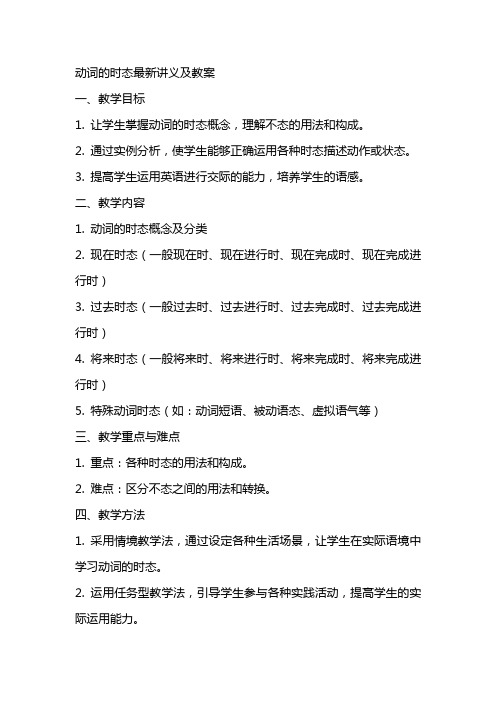
动词的时态最新讲义及教案一、教学目标1. 让学生掌握动词的时态概念,理解不态的用法和构成。
2. 通过实例分析,使学生能够正确运用各种时态描述动作或状态。
3. 提高学生运用英语进行交际的能力,培养学生的语感。
二、教学内容1. 动词的时态概念及分类2. 现在时态(一般现在时、现在进行时、现在完成时、现在完成进行时)3. 过去时态(一般过去时、过去进行时、过去完成时、过去完成进行时)4. 将来时态(一般将来时、将来进行时、将来完成时、将来完成进行时)5. 特殊动词时态(如:动词短语、被动语态、虚拟语气等)三、教学重点与难点1. 重点:各种时态的用法和构成。
2. 难点:区分不态之间的用法和转换。
四、教学方法1. 采用情境教学法,通过设定各种生活场景,让学生在实际语境中学习动词的时态。
2. 运用任务型教学法,引导学生参与各种实践活动,提高学生的实际运用能力。
3. 采用讲解与练习相结合的方法,让学生在课堂内外巩固所学知识。
五、教学步骤1. 引入:通过问答方式引导学生回顾已学过的动词时态知识。
2. 新课讲解:讲解本节课要学习的时态,如一般现在时、现在进行时等。
3. 实例分析:用具体例子解释不态的用法,让学生加深理解。
4. 课堂练习:设计相关练习题,让学生即时巩固所学知识。
5. 小组讨论:分组让学生讨论如何运用所学时态进行实际交流。
6. 课堂小结:总结本节课所学内容,强调重点和难点。
7. 课后作业:布置相关作业,让学生课后巩固复习。
8. 教学评价:及时了解学生掌握情况,对教学进行调整。
六、教学活动设计1. 互动游戏:设计一个动词时态的互动游戏,如“时态猜猜乐”,让学生在游戏中复习和巩固不态的用法。
2. 角色扮演:让学生分组进行角色扮演,模拟不同场景下的动词时态运用,如在餐馆、学校、家庭等场景中运用不态描述动作。
3. 故事创作:让学生运用所学时态创作一个简短的故事,要求故事中包含不态的句子,以此检验学生对动词时态的掌握程度。
教育辅导个性化教案动词的时态

教育辅导个性化教案——动词的时态一、教学目标:1. 让学生理解动词的时态概念,掌握一般现在时、一般过去时和一般将来时的构成及用法。
2. 培养学生运用动词时态进行准确表达的能力。
二、教学内容:1. 动词的时态概念及分类2. 一般现在时的构成及用法3. 一般过去时的构成及用法4. 一般将来时的构成及用法5. 动词时态的实践练习三、教学重点与难点:1. 教学重点:动词的时态概念、一般现在时、一般过去时和一般将来时的构成及用法。
2. 教学难点:一般将来时的构成及用法,以及动词时态在实际语境中的运用。
四、教学方法:1. 任务型教学法:通过设定各种实际情境,让学生在完成任务的过程中运用动词的时态。
2. 互动式教学法:引导学生参与课堂讨论,增强学生对动词时态的理解和运用。
3. 直观教学法:利用图片、动画等直观教具,帮助学生形象地理解动词的时态。
五、教学步骤:1. 引入:通过一个简单的谜语,引发学生对动词时态的好奇心,如:“小明跑得快,小华跳得高,它们谁能告诉我,现在几点了?”(学生回答:“They can't, because they are not here.”)2. 讲解:讲解动词的时态概念,介绍一般现在时、一般过去时和一般将来时的构成及用法。
3. 实践:进行一些动词时态的练习,如填空、造句等,让学生在实际语境中运用所学知识。
4. 互动:学生分组进行角色扮演,运用动词的时态进行对话,教师巡回指导。
5. 总结:对本节课的内容进行回顾和总结,强调动词时态的重要性和用法。
六、教学评估:1. 课堂参与度:观察学生在课堂活动中的参与程度,了解他们对动词时态的理解和运用情况。
2. 练习完成情况:检查学生完成练习的情况,评估他们对动词时态的掌握程度。
3. 对话表演:评价学生在角色扮演中的表现,了解他们在实际语境中运用动词时态的能力。
七、作业布置:1. 课后练习:布置一些关于动词时态的练习题,要求学生回家完成,以巩固所学知识。
英语教案学习动词时态

英语教案学习动词时态学案一:动词时态概述动词时态是英语语法中的一个重要部分,它用于表达动作发生的时间。
掌握动词时态对于学习英语非常重要,本学案将帮助学习者全面了解常见的英语动词时态,并提供相关例句和练习。
学案二:一般现在时一般现在时用于描述现在经常发生的动作、习惯、真理和客观事实等。
在句子中,一般现在时使用动词的原形。
以下是一些例子:1. She goes to school every day.2. I eat breakfast at 8 o'clock.3. The sun rises in the east.练习题:1. My sister _______ (like/likes) to play the piano.2. The train _______ (leave/leaves) at 9 o'clock in the morning.学案三:一般过去时一般过去时用于描述发生在过去的动作或状态。
在句子中,一般过去时使用动词的过去式。
以下是一些例子:1. He studied English last night.2. They went to the park yesterday.3. We lived in London for five years.练习题:1. Last week, I _______ (visit/visited) my grandparents.2. They _______ (watched/watch) a movie in the cinema.学案四:一般将来时一般将来时用于描述将来发生的动作或状态。
在句子中,一般将来时使用助动词"will"或"be going to"加上动词的原形。
以下是一些例子:1. I will go to the beach tomorrow.2. She is going to study abroad next year.3. They will have a party next Saturday.练习题:1. My parents _______ (buy) a new car next month.2. We _______ (have) a meeting at 3 p.m.学案五:现在进行时现在进行时用于描述当前正在发生的动作。
动词时态教案
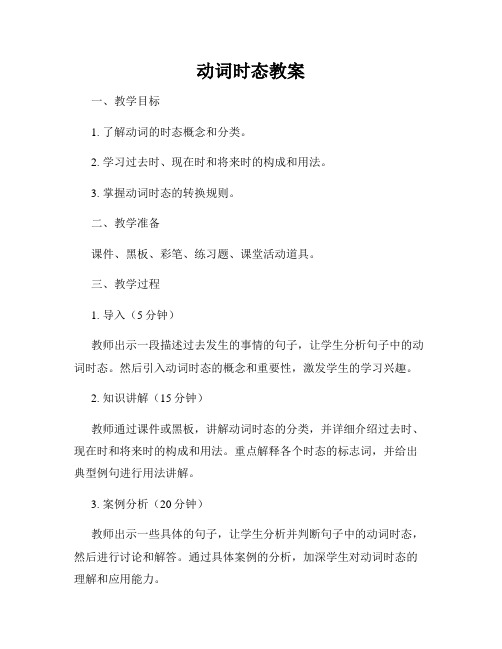
动词时态教案一、教学目标1. 了解动词的时态概念和分类。
2. 学习过去时、现在时和将来时的构成和用法。
3. 掌握动词时态的转换规则。
二、教学准备课件、黑板、彩笔、练习题、课堂活动道具。
三、教学过程1. 导入(5分钟)教师出示一段描述过去发生的事情的句子,让学生分析句子中的动词时态。
然后引入动词时态的概念和重要性,激发学生的学习兴趣。
2. 知识讲解(15分钟)教师通过课件或黑板,讲解动词时态的分类,并详细介绍过去时、现在时和将来时的构成和用法。
重点解释各个时态的标志词,并给出典型例句进行用法讲解。
3. 案例分析(20分钟)教师出示一些具体的句子,让学生分析并判断句子中的动词时态,然后进行讨论和解答。
通过具体案例的分析,加深学生对动词时态的理解和应用能力。
4. 时态转换规则讲解(15分钟)教师讲解常见动词时态的转换规则,并给出练习题进行巩固。
教师可以设计一些互动活动,鼓励学生积极参与,提高动手能力。
5. 学生练习(20分钟)教师发放练习题,让学生独立完成。
然后进行答案讲解和讨论,纠正学生的错误,并解释相关规则和注意事项。
6. 拓展延伸(15分钟)教师出示一些关于动词时态的谜语或小故事,让学生进行阅读和理解,并回答相关问题。
通过拓展延伸,增加学生对动词时态知识的兴趣和记忆。
7. 总结归纳(5分钟)教师对本节课的教学内容进行总结归纳,重点强调动词时态的重要性和学习要点。
四、课堂活动1. 动词时态竞赛:将学生分成若干小组,出示一系列句子,要求学生迅速判断句子中的动词时态,并给出答案。
第一个回答正确的小组得分。
2. 时态转换填词:教师给出一些句子,将句子中的动词时态划线,要求学生将划线部分改写成其他时态,并填入正确的动词形式。
五、作业布置要求学生完成动词时态相关练习题,并按要求完成写一篇关于自己周末计划的作文,要求使用过去时、现在时和将来时。
六、板书设计动词时态过去时现在时将来时七、教学反思本节课通过多种教学方法,引导学生了解和掌握动词时态的概念、分类和用法。
英语动词时态讲解教案(5篇范文)

英语动词时态讲解教案(5篇范文)第一篇:英语动词时态讲解教案英语动词时态讲解(共5课时)一:总述:动词的构成(5种)与时态(8种)二:分述:动词的构成 1.be 动词1)be动词的几种形式: am is arewas werebeingBeen 2)与名词、数词、形容词、介词连用 1)I am a doctor.2)He is ten.3)They are tired.4)The cat is under the table.3)There be 句型用于不可数名词和可数名词单数之前There is a pen on the desk.There is some water in the glass.用于复数名词之前 There are some sheep in the hill.用于一般将来时There is going to be a film in our school next Sunday.用于一般过去时 There was a book on the desk yesterday.注意:请根据时态和句中的名词选择适当形式。
4)Be 动词在时态中的运用在现在进行时中We are talking.在过去进行时中We were talking at this time yesterday 2.助动词1)几种形式1.do /don’t2.Does/ doesn’t3.Did/ didn’t4.will /won’t5.have haven’t /has hasn’t/had hadn’t 2)对句子进行否定和疑问1)Do you get up early every day? 2)I didn’t have lunch yesterday.3)Will you be back soon? 4)He hasn’t finished the work yet.在反意疑问句中5)He works in a school, doesn’t he? 6)She has never been there,has she? 在倒装句中7)They helped the farmers , so did we.8)I won’t visit thefamous singer,neither will he.3.情态动词共同特点: 情态动词后面跟动词原型,无论否定、疑问、倒装句、或反意疑问句都用情态动词1 只有时态变化,没有人称变化。
动词时态教案

动词时态教案关键信息项1、教学目标知识目标能力目标情感目标2、教学重难点重点难点3、教学方法4、教学过程导入讲解练习总结作业布置5、教学资源6、教学评估11 教学目标111 知识目标学生能够准确理解和掌握一般现在时、一般过去时、一般将来时、现在进行时、过去进行时和现在完成时的基本概念和构成形式。
学生能够区分不同动词时态在语境中的用法,并能正确运用这些时态来表达各种时间关系。
112 能力目标通过课堂练习和课后作业,培养学生运用不同动词时态进行书面和口头表达的能力。
提高学生在阅读理解和听力理解中对动词时态的敏感度,能够准确理解和把握文本中所使用的时态。
113 情感目标激发学生对英语语法学习的兴趣,增强学习英语的自信心。
培养学生严谨的语言学习态度和逻辑思维能力。
12 教学重难点121 重点各种动词时态的构成形式和基本用法。
一般现在时与现在进行时、一般过去时与过去进行时、现在完成时与一般过去时的区别和联系。
122 难点现在完成时的用法,尤其是与时间状语的搭配。
过去完成时的构成和用法。
在复杂语境中正确选择和运用合适的动词时态。
13 教学方法采用讲授法、演示法、练习法、讨论法相结合的教学方法。
通过多媒体课件、例句展示、情景模拟等方式辅助教学,帮助学生直观理解和掌握动词时态。
14 教学过程141 导入通过播放一段包含不同动词时态的英语视频或讲述一个有趣的故事,引导学生关注动词时态的变化,激发学生的学习兴趣。
142 讲解依次讲解一般现在时、一般过去时、一般将来时、现在进行时、过去进行时和现在完成时的构成形式、用法和常见的时间状语。
结合例句和语境,详细分析不同时态之间的区别和联系,帮助学生理解和掌握。
143 练习安排课堂练习,包括选择题、填空题、造句等,让学生在实践中巩固所学的动词时态知识。
组织小组讨论,让学生相互交流和纠正错误,提高学习效果。
144 总结对本节课所学的动词时态进行总结,强调重点和难点,帮助学生梳理知识框架。
动词时态教案

动词时态教案一、教学目标1、让学生理解并掌握英语中常见动词时态的形式、用法和意义。
2、能够正确运用不同的动词时态进行口头和书面表达。
3、培养学生在实际语境中准确判断和使用动词时态的能力。
二、教学重难点1、重点一般现在时、一般过去时、一般将来时、现在进行时、过去进行时、现在完成时、过去完成时这七种时态的构成和用法。
各种时态在不同语境中的正确运用,以及时态之间的转换。
2、难点现在完成时与一般过去时的区别。
过去完成时的用法和理解。
时态在复合句中的运用,如宾语从句、状语从句中的时态一致性。
三、教学方法1、讲授法:讲解各个时态的基本概念、构成和用法。
2、练习法:通过练习题让学生巩固所学知识,加深对时态的理解和运用。
3、情景教学法:创设各种实际情景,让学生在具体语境中感受和运用动词时态。
四、教学过程1、导入通过展示一些包含不同时态的句子,如:“I play basketball every day” “I played basketball yesterday” “I will play basketball tomorrow” 让学生观察并思考这些句子中动词形式的变化,从而引出动词时态的概念。
2、一般现在时(1)构成:主语+动词原形(当主语为第三人称单数时,动词要加“s”或“es”)(2)用法:表示经常发生的动作或存在的状态;表示客观事实或普遍真理;表示主语的性格、能力、特征等。
(3)例句:He gets up at six every morning The earth moves around the sun3、一般过去时(1)构成:主语+动词的过去式(2)用法:表示过去某个时间发生的动作或存在的状态;表示过去经常或反复发生的动作。
(3)例句:I went to Beijing last year He often played football when he was a child4、一般将来时(1)构成:“will +动词原形”或“be going to +动词原形”(2)用法:表示将来要发生的动作或存在的状态。
动词时态教案

动词时态教案教案:动词时态一、教学内容本节课的教学内容选自人教版小学英语教材六年级下册,第三章第三单元。
本节课主要教授一般现在时、一般过去时和一般将来时的用法和构成。
通过本节课的学习,学生能够掌握一般现在时、一般过去时和一般将来时的构成,能够在适当的语境中运用这三种时态进行交流。
二、教学目标1. 学生能够掌握一般现在时、一般过去时和一般将来时的构成和用法。
2. 学生能够在适当的语境中运用这三种时态进行交流。
3. 学生能够通过观察、模仿和练习,提高自己的英语口语表达能力。
三、教学难点与重点1. 教学难点:一般将来时的构成和用法。
2. 教学重点:一般现在时、一般过去时和一般将来时的用法和构成。
四、教具与学具准备1. 教具:PPT、动词卡片、时间状语卡片。
2. 学具:课本、练习本、动词卡片、时间状语卡片。
五、教学过程1. 导入:通过播放一首英文歌曲,引导学生进入英语学习氛围。
2. Presentation:教师通过PPT展示一般现在时、一般过去时和一般将来时的用法和构成,让学生初步感知这三种时态。
3. Practice:学生分组进行练习,用一般现在时、一般过去时和一般将来时描述自己或他人的行为、经历和计划。
4. Consolidation:学生进行角色扮演,运用这三种时态进行对话,提高口语表达能力。
六、板书设计板书设计如下:时态构成用法一般现在时 s, es 描述经常发生的事情一般过去时 ed 描述过去发生的事情一般将来时 will + 动词原形描述将来发生的事情七、作业设计1. 作业题目:用一般现在时、一般过去时和一般将来时写一篇关于节日的短文。
答案:一般现在时:I like festivals. I like Christmas because I can get presents. I can see my family and friends. I can eat delicious food.一般过去时:Yesterday was Halloween. I wore a costume and went trickortreating. I got a lot of candy. It was fun.一般将来时:Next month is Thanksgiving. I will see my family and friends. We will have a big dinner. I will be happy.2. 作业题目:用动词卡片和时间状语卡片进行对话,运用一般现在时、一般过去时和一般将来时。
动词的时态教案

动词的时态教案教案标题:动词的时态教案教案目标:1. 理解动词时态的概念和作用;2. 掌握英语中常见的动词时态;3. 能够正确运用不同的动词时态进行交流。
教学内容:1. 时态的定义和分类;2. 现在时态、过去时态和将来时态的用法和标志词;3. 动词时态的转换;4. 练习和应用。
教学准备:1. 教学课件或黑板;2. 学生练习册或作业本;3. 讲解用的例句和练习题。
教学过程:引入:1. 利用图片或视频引入动词时态的概念,让学生了解时态的作用和重要性。
教学主体:步骤一:时态的定义和分类1. 通过示意图或教学课件,向学生解释时态的定义和分类。
2. 介绍现在时态、过去时态和将来时态的基本用法和区别。
步骤二:现在时态1. 详细讲解现在时态的用法和标志词,如一般现在时、现在进行时和现在完成时。
2. 提供例句和练习题,让学生练习运用现在时态。
步骤三:过去时态1. 详细讲解过去时态的用法和标志词,如一般过去时、过去进行时和过去完成时。
2. 提供例句和练习题,让学生练习运用过去时态。
步骤四:将来时态1. 详细讲解将来时态的用法和标志词,如一般将来时、将来进行时和将来完成时。
2. 提供例句和练习题,让学生练习运用将来时态。
步骤五:动词时态的转换1. 教授动词时态的转换规则和注意事项。
2. 提供例句和练习题,让学生练习将动词从一种时态转换为另一种时态。
练习和应用:1. 分发学生练习册或作业本,让学生完成相关练习题。
2. 通过口头交流或小组讨论,让学生运用所学的动词时态进行实际情景对话。
总结:1. 对动词时态的重要性和运用进行总结;2. 强调学生继续练习和巩固所学的动词时态知识。
拓展活动:1. 提供更多的练习题和挑战题,让学生进一步巩固和扩展动词时态的运用;2. 鼓励学生使用动词时态进行写作或口头表达,展示他们的学习成果。
教学反思:1. 教师可以观察学生在练习和应用环节的表现,及时给予指导和反馈;2. 教师可以根据学生的学习情况,调整教学策略和教学内容,以提高教学效果。
初中动词的时态教案
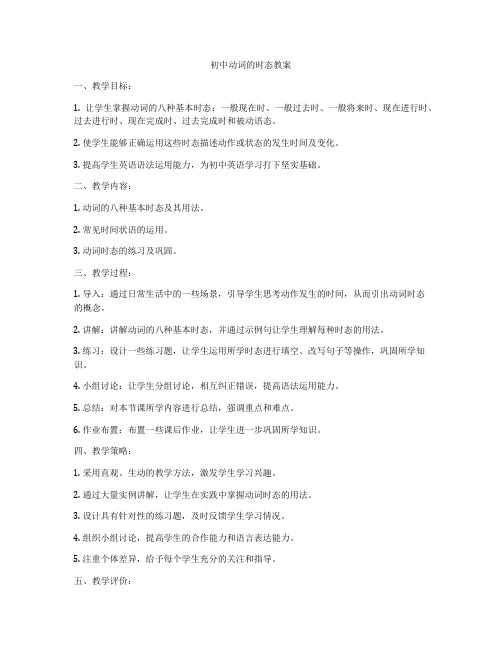
初中动词的时态教案一、教学目标:1. 让学生掌握动词的八种基本时态:一般现在时、一般过去时、一般将来时、现在进行时、过去进行时、现在完成时、过去完成时和被动语态。
2. 使学生能够正确运用这些时态描述动作或状态的发生时间及变化。
3. 提高学生英语语法运用能力,为初中英语学习打下坚实基础。
二、教学内容:1. 动词的八种基本时态及其用法。
2. 常见时间状语的运用。
3. 动词时态的练习及巩固。
三、教学过程:1. 导入:通过日常生活中的一些场景,引导学生思考动作发生的时间,从而引出动词时态的概念。
2. 讲解:讲解动词的八种基本时态,并通过示例句让学生理解每种时态的用法。
3. 练习:设计一些练习题,让学生运用所学时态进行填空、改写句子等操作,巩固所学知识。
4. 小组讨论:让学生分组讨论,相互纠正错误,提高语法运用能力。
5. 总结:对本节课所学内容进行总结,强调重点和难点。
6. 作业布置:布置一些课后作业,让学生进一步巩固所学知识。
四、教学策略:1. 采用直观、生动的教学方法,激发学生学习兴趣。
2. 通过大量实例讲解,让学生在实践中掌握动词时态的用法。
3. 设计具有针对性的练习题,及时反馈学生学习情况。
4. 组织小组讨论,提高学生的合作能力和语言表达能力。
5. 注重个体差异,给予每个学生充分的关注和指导。
五、教学评价:1. 通过课堂表现、练习完成情况和课后作业,评价学生对动词时态的掌握程度。
2. 定期进行测试,了解学生对所学知识的巩固情况。
3. 鼓励学生积极参与课堂活动,提高他们的自信心和学习兴趣。
六、教学资源:1. PPT课件:展示动词时态的用法和示例句。
2. 练习题:用于巩固所学知识。
3. 教学视频或录音:辅助讲解和演示。
4. 参考书籍:提供更多学习资料。
七、教学时间:1课时(40分钟)通过以上教学设计,相信学生能够系统地掌握动词的八种基本时态,并在实际应用中灵活运用,为今后的英语学习奠定坚实基础。
教育辅导个性化教案动词的时态

教育辅导个性化教案——动词的时态一、教学目标1. 让学生理解动词的时态概念,掌握一般现在时、一般过去时和一般将来时的构成和用法。
2. 培养学生运用动词的时态进行交际的能力。
3. 提高学生对英语时态的兴趣和积极性。
二、教学内容1. 动词的时态概念及分类2. 一般现在时的构成和用法3. 一般过去时的构成和用法4. 一般将来时的构成和用法5. 动词时态的辨别和运用三、教学重点与难点1. 重点:动词的时态概念、一般现在时、一般过去时和一般将来时的构成和用法。
2. 难点:动词时态的辨别和运用。
四、教学方法1. 任务型教学法:通过完成具体的任务,让学生在实践中学习和运用动词的时态。
2. 情境教学法:创设真实的语境,让学生在特定的情境中学习动词的时态。
3. 互动式教学法:引导学生参与课堂互动,提高学生的参与度和积极性。
五、教学过程1. 导入:通过图片或故事引入动词的时态概念,激发学生的学习兴趣。
2. 新课呈现:讲解一般现在时、一般过去时和一般将来时的构成和用法。
3. 实践环节:学生分组进行角色扮演,运用动词的时态进行交际。
4. 巩固环节:通过练习题和游戏,让学生进一步巩固所学内容。
5. 总结与作业:对本节课的内容进行总结,布置相关作业,让学生巩固所学。
六、教学评价1. 评价方式:课堂表现、练习完成情况、小组活动参与度。
2. 评价标准:a. 能够正确运用动词的时态进行交际。
b. 能够辨别并运用不同动词时态描述动作。
c. 课堂表现积极,参与度高。
七、教学拓展1. 引导学生运用所学动词时态编写小故事。
2. 组织学生进行动词时态的主题演讲比赛。
3. 推荐学生阅读关于动词时态的英语文章,加深对时态的理解。
八、教学资源1. 教材:英语课本、辅导书等相关资料。
2. 教具:黑板、多媒体设备、动词时态图片、卡片等。
3. 网络资源:英语学习网站、在线教育平台等。
九、教学计划1. 课时安排:本节课共计40分钟。
2. 教学进度:按照教案所述内容进行教学,根据学生的掌握情况适当调整教学节奏。
动词时态学案概要

动词时态学案概要英语中动词时态1.重点复习动词六种时态的基本结构、主要用法及区别(一般现在时、一般过去时、一般将来时、现在进行时、过去进行时和现在完成时)2.复习过去将来时、过去完成时态的基本用法3.学会运用数轴法分析时态一、学习目标二、学习重点1.动词六种时态的基本结构、主要用法及区别2.学会运用数轴法分析时态三、学习难点动词六种时态的基本结构、主要用法及区别四、学习过程Part 1一般现在时基本构成1.Be动词肯定句:主语+Be(am/is/are)+其它否定句:主语+Be(am/is/are)+ not +其它一般疑问句:Be(am/is/are)+主语+其它例句: He is a worker. He is not a worker. Is he a worker? 2. 一般行为动词肯定句:主语+动词原形(单三形式)+其它否定句:主语+don’t+动词原形+其它一般疑问句:Do+主语+动词原形+其它例句:I often play football.I don’t often play football. Do you often pla y football. Yes, I do./No, I don’t. 3. There be 句型否定句:There be+not+其它一般疑问句:Be there+其它例句:There is a book and ten schoolbags on the desk. There are ten schoolbags and a book on the desk. There isn’t a book on the desk. Is there a book on the desk?第三人称单数的变化规律一般现在时时态下,当主语是以下几种情况时,谓语动词用动词的第三人称单数形式。
1. 人称代词为he/she/it She usually has lunch at twelve.2. 单个人名、地名或称呼作主语 Beijing is in China.3. 单数可数名词或“this/that/the+单数可数名词”作主语 This book is yours.4. 不定代词someone/somebody/nobody/everything/something等及this/that 作主语 There is something wrong with the watch. 5. 不可数名词The bread is very small. 6. 数字或字母“6”is a lucky number.动词单三形式变化规律表动词单三一般情况 + s 情形构成方法读音清辅音后读/s/,浊辅音和元音后读/z/,ts结尾读/ts/,ds结尾读/dz/ 例词 work – works sound – sounds play - plays形式的变化规律以s、sh、ch、某、o结尾的动词 watch –watches + es 读/iz/ guess – guesses go - goes 变y为i后加es study – studies 读/z/ carry – carries worry – worries have –has 辅音字母加y结尾的名词特殊形式的变化用法1.表示经常性、习惯性的动作或存在的状态例句:They often go to school by bike. She usually has lunch at 12:00. His father is a doctor. I like watching TV.2.表示客观事实或普遍真理(注:格言或警句中也用一般现在时)例句:The moon moves round the earth. There are seven days in a week. Birds do not like milk. California is in America. Pride goes before a fall. Time and tide waits for no man.3.表示正在进行的动作或状态(1)较短一段时间内存在的状态例句:He lives in Beijing now. He needs help right now. She is not here now.(2)在一些倒装句中,表示动作正在进行。
- 1、下载文档前请自行甄别文档内容的完整性,平台不提供额外的编辑、内容补充、找答案等附加服务。
- 2、"仅部分预览"的文档,不可在线预览部分如存在完整性等问题,可反馈申请退款(可完整预览的文档不适用该条件!)。
- 3、如文档侵犯您的权益,请联系客服反馈,我们会尽快为您处理(人工客服工作时间:9:00-18:30)。
英语中动词时态一、学习目标1. 重点复习动词六种时态的基本结构、主要用法及区别(一般现在时、一般过去时、一般将来时、现在进行时、过去进行时和现在完成时)2. 复习过去将来时、过去完成时态的基本用法3. 学会运用数轴法分析时态二、学习重点1. 动词六种时态的基本结构、主要用法及区别2. 学会运用数轴法分析时态三、学习难点动词六种时态的基本结构、主要用法及区别四、学习过程Part 1一般现在时基本构成1. Be动词肯定句:主语+Be(am/is/are)+其它否定句:主语+Be(am/is/are)+ not +其它一般疑问句:Be(am/is/are)+主语+其它例句:He is a worker.He is not a worker.Is he a worker?2. 一般行为动词肯定句:主语+动词原形(单三形式)+其它否定句:主语+don’t+动词原形+其它一般疑问句:Do+主语+动词原形+其它例句:I often play football.I don’t often play football.Do you often play football.Yes, I do./No, I don’t.3. There be 句型否定句:There be+not+其它一般疑问句:Be there+其它例句:There is a book and ten schoolbags on the desk.There are ten schoolbags and a book on the desk.There isn’t a book on the desk.Is there a book on the desk?第三人称单数的变化规律一般现在时时态下,当主语是以下几种情况时,谓语动词用动词的第三人称单数形式。
1.人称代词为he/she/itShe usually has lunch at twelve.2.单个人名、地名或称呼作主语Beijing is in China.3.单数可数名词或“this/that/the+单数可数名词”作主语This book is yours.4.不定代词someone/somebody/nobody/everything/something等及this/that作主语There is something wrong with the watch.5.不可数名词The bread is very small.6.数字或字母“6”is a lucky number.动词单三形式变化规律表形式的变化规律以s、sh、ch、x、o结尾的动词+ es 读/iz/watch – watchesguess – guessesgo - goes辅音字母加y结尾的名词变y为i后加es读/z/study – studiescarry – carriesworry – worries 特殊形式的变化have – has用法1. 表示经常性、习惯性的动作或存在的状态一般现在时可用来表示在过去到以后很长一段时间内的一个不断重复或经常发生的动作,以前有、现在有并且以后还会存在。
这个动作可以日常发生的事情,也可以是一种习惯、一个爱好,还可以是一个人的职业、性格、能力。
与always、usually、often、sometimes、every day (week/month)等连用。
(注:时常遗忘或不做的事情也可以用一般现在时)例句:They often go to school by bike.She usually has lunch at 12:00.His father is a doctor.I like watching TV.2. 表示客观事实或普遍真理(注:格言或警句中也用一般现在时)例句:The moon moves round the earth.There are seven days in a week.Birds do not like milk.California is in America.Pride goes before a fall.Time and tide waits for no man.3. 表示正在进行的动作或状态(1)较短一段时间内存在的状态例句:He lives in Beijing now.He needs help right now.She is not here now.(2)在某些倒装句中,表示动作正在进行。
例句:Here comes the bus. = The bus is coming.There goes the bell. = The bell is ringing.4. 表示将来的动作或状态在时间、条件、让步状语从句中,主句是一般将来时,从句用一般现在时表示将来的动作或状态。
“主将从现”这一语法现象的重要连词有:if (如果),as soon as (一....就...),when(当...时候),before,after,until(直到not..until直到...才) 。
例句:If you come, we will wait for you.When he gets here, the work will be finished.Though he disagrees with us, he will do as we decided.I’ll tell you the news as soon as you come back.5. 表示过去的动作和状态小说故事用一般现在时代替一般过去时。
新闻报道类的内容,为了体现其“新鲜”性,也用一般现在时来表示过去发生的事情。
例句:A man kills 14 students in one minute yesterday.Mary steps into the bedroom and sees her husband lying in the bed motionlessly.实战演练1. Jenny!Do you know that one-third of the boys in our class _________ the singer Zhang Shaohan?A. likeB. likesC. liking2. Betty will ring me up when she _______ in Beijing.A. arriveB. arrivesC. arrivedD. will arrive3. Although Bill i sn’t rich enough, he often ______ money to the poor.A. will giveB. was givingC. givesD. gave4. ----Can your father drive?----Yes, and he ______ to work every day.A. is drivingB. droveC. drivesD. has driven5. This girl is ready to help people any time. When she is on the bus, she alwaysher seat to someone in need.A. givesB. giveC. gaveD. giving6. If it ________ this Saturday, we ________ for a picnic.A. won’t rain; shall goB. doesn’t rain; will goC. isn’t rain; goD. doesn’t rain; goPart 2一般过去时用法1.过去某段时间习惯性或经常性的动作或状态表示在过去的很长一段时间内的行惯性或经常发生的动作或状态,现在已经没有了。
这个动作可以日常发生的事情,也可以是一种习惯、一个爱好,还可以是一个人的职业、性格、能力。
常与表示过去的时间连用,如last year, some years ago等以及由when等引导的时间状语从句。
例句:When I was in the countryside, I often called on my old friends.I usually went to the cinema with Lily some years ago.She used to go for a walk after supper, but now she prefers to stay at home.(used to 表示过去常常做某事)2.过去某个特定时间发生的一个动作、存在的状态或一系列的动作例句:Tom didn’t come to class yesterday.We went to dance last night.I finished work, walked to the beach, and found a nice place to swim.3. 代替过去将来时在时间、条件、让步状语从句中,常用一般过去时代替过去将来时。
例句:They said they would let us know if they heard any news about him.He promised that when he went to the bookstore, he would buy me a book. They told us that they would not leave until she came back.let sb. do sth.buy sb. sth./buy sth for sb.基本构成1. Be动词肯定句:主语+Be(was/were)+其它否定句:主语+Be(was/were)+ not +其它一般疑问句:Be(was/were)+主语+其它例句:He was a worker two years ago.He was not a worker two years ago.Was he a worker two years ago.2. 一般行为动词肯定句:主语+动词过去式+其它否定句:主语+didn’t+do+其它一般疑问句:Did+主语+do+其它例句:I often played football when I was a child.I did n’t often play football when I was a child.Did you often play football when you were a child?(注意人称和相应谓语动词的变化)Yes, I did./No, I didn’t.3. There be(was/were)句型否定句:there be(was/were)+not+其它一般疑问句:be(was/were)there+其它There was one book and ten schoolbags on the desk last night. There were ten schoolbags and one book on the desk last night. There was n’t one book on the desk last night.Was there a book on the desk last night?动词过去式的变化规律动词过去式的变化规律闭音节:单个元音字母后面有辅音字母(r 除外)且以辅音字母结尾的重读音节,就是一个辅音、一个元音字母后跟一个辅音字母的单词。
